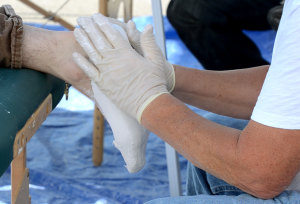
Prescription foot orthotics are known to relieve a wide range of symptoms including joint and back pain, heel spurs or plantar fasciitis, shin splints, arthritis, and certain types of headaches. They also provide therapeutic support and stabilization to improve athletic performance such as distance running, golf swings and agility on the basketball and volleyball courts. A well-fitting, properly manufactured foot orthotic offers numerous benefits to the user. In contrast, a poorly designed foot orthotic may be ineffective or even produce counterproductive results.
Foot orthotics vary widely in price, quality and functionality. There are simple, off-the-shelf foot orthotics that offer a one-style-fits-all solution in a popular brand of choice. Then there are prefabricated orthotics whose components are customized to offer slightly more targeted results. Finally, there are prescription foot orthotics, which are manufactured exactly to the specifications prescribed by a foot-care professional. Prescription foot orthotics, when produced in a reputable lab, are designed with the individual in mind and, thus, offer complete control over corrective therapies.
However, the mere fact that a foot orthotic is manufactured by prescription does not guarantee optimal results. To be effective, a foot orthotic must be prescribed by a foot-care professional who understands the choices available in the manufacturing process and what may go wrong when choices are mistakenly made or overlooked. For example, following are a few common pitfalls that foot-care professionals must avoid when prescribing foot orthotics for their patients:
1) Missing the objective when writing the prescription:
When a foot-care professional prescribes an orthotic, it is usually with a specific objective in mind. The symptoms to alleviate may include pain, poor posture or lack of motor control. Without knowing the objective, the pedorthist is limited to following those few instructions outlined in the prescription. Whereas, if the objective were known, the pedorthist might be able to offer recommendations and verify choices that need to be made in creating and refining the device.
2) Suboptimal positioning when casting:
It is common to cast or create a foam impression in the neutral position for prescribing orthotics. Yet, there may be times when neutral positioning may not be the best choice. For example, if the user is often in a weight bearing position when wearing the foot orthotics, a neutral cast may result in an overly high arch. Consider casting for the position the user will most often take when wearing the orthotics.
3) Over Compensating:
In certain cases, a perfect position of the arch is not the best choice when prescribing an orthotic. There may simply be too extreme a change between the patient’s current gait and stance in comparison to the desired result. When a big change is necessary, it may be best to make it gradually or in stages. Otherwise, the pain and discomfort may prohibit the user from wearing the orthotics and benefitting whatsoever.
4) Under Compensating:
Similar to the problem of over compensation, under compensating can also diminish the benefit an orthotic is designed to deliver. Under compensation can occur when the patient is not entirely articulate or forthcoming with the problems being experienced. It helps to thoroughly interview a patient in order to understand exactly when and where the problem persists.
5) Wrong Solution:
There are dozens of methods and hundreds of materials with which to manufacture an orthotic device. Depending on the purpose of the foot orthotic, the material used in its construction may be an enhancement or detriment. The foot-care professional should take time to become familiar and up-to-date with the inputs offered by the orthotics lab. Working with an orthotics lab that takes a consultative approach to manufacturing is also helpful.
With more than 30 years of experience in manufacturing prescription orthotics, North Star Podiatric Lab has compiled a reference list of common problems and orthotic solutions to assist foot-care professionals in knowing the materials and products available. A copy of this reference tool may be obtained here:
[easy_sign_up title=”Common Problems and Orthotic Solutions”]
North Star Podiatric Lab is an ABC-certified facility. Its mission is to provide quality prescription foot orthotics that conform to the technical standards as defined by the Prescription Foot Orthotics Laboratory Association. For more information call 651-426-9388 or toll-free, 800-842-2171, or visit www.northstarpodiatriclab.com.
